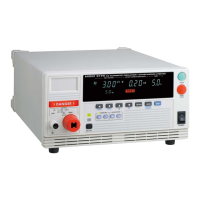6.6 Changing the Output Voltage during the withstanding test
91
6
The output voltage can be changed and the withstanding condition can be con-
firmed during the withstanding test.
When changing the voltage using the panel key
1. See "9.5 Interface Command "START"" (p. 186),
Effecting the output voltage change
2. Start the test.
3. Move on to the next key, taking care not to touch the tested object and test
lead during the test.
To increase the test voltage:
ON/OFF +
..................Increasing the voltage by 10 V each
SHIFT + .....................Increasing the voltage by 100 V each
To decrease the test voltage:
ON/OFF +
..................Decreasing the voltage by 10 V each
SHIFT + .....................Decreasing the voltage by 100 V each
Note: Test voltage changed during output will not be saved
To change the voltage in RS-232C and GP-IB
1. See "9.5 Interface Command "START"" (p. 186),
Effecting the output voltage change
2. Start the test.
3.
Send voltage setting command from RS-232C and GP-IB during testing
”:CONFigure:WITHstand:VOLTage voltage value (0.20kV to 5.00 kV)”
Note: Test voltage changed during output will not be saved
6.6 Changing the Output Voltage during the
withstanding test
• To prevent electric shock, never touch the tested object or test lead.
• When changing the output voltage from RS-232C or GP-IB, it is difficult
to grasp the timing of voltage changes as the voltage changes automati-
cally. As electric shock accidents can happen easily, take measures to
prevent people from coming near the instrument or the tested object
when changing the output voltage automatically.
• When the tested object in use shows dependency on voltage (impedance of
ceramic condenser, etc.), the waveforms of the output voltage may become
distorted. The tested object may malfunction depending on the distortion of the
waveforms.
• When the tested object in use possesses an inductivity like a coil, a voltage
higher than the pre-set voltage may appear transitionally, causing damage in
the tested object.
• The tested object may damage if a voltage higher than necessary is supplied.
Be careful when setting the output voltage to ensure that the tested object
does not receive a voltage higher than necessary.
• A contact error will occur when the output voltage is changed during the test
and the contact check upper-limit voltage and lower-limit voltage are
exceeded.

